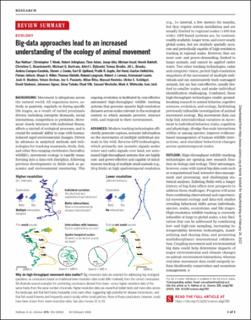Big-data approaches lead to an increased understanding of the ecology of animal movement
Ran, Nathan; Monk, Christopher T.; Arlinghaus, Robert; Adam, Timo; Alós, Josep; Assaf, Michael; Baktoft, Henrik; Beardsworth, Christine E.; Bertram, Michael G.; Bijleveld, Allert I.; Brodin, Tomas; Brooks, Jill L.; Campos-Candela, Andrea; Cooke, Steven J.; Gjelland, Karl Øystein; Gupte, Pratik R.; Harel, Roi; Hellstrom, Gustav; Jeltsch, Florian; Killen, Shaun S.; Klefoth, Thomas; Langrock, Roland; Lennox, Robert; Lourie, Emmanuel; Madden, Joah R.; Orchan, Yotam; Pauwels, Ine S.; Říha, Milan; Roeleke, Manuel; Schlägel, Ulrike E.; Shohami, David; Signer, Johannes; Toledo, Sivan; Vilk, Ohad; Westrelin, Samuel; Whiteside, Mark A.; Jarić, Ivan
Peer reviewed, Journal article
Published version

Åpne
Permanent lenke
https://hdl.handle.net/11250/3010125Utgivelsesdato
2022Metadata
Vis full innførselSamlinger
- Publikasjoner fra CRIStin - NINA [2397]
- Scientific publications [1423]
Originalversjon
10.1126/science.abg1780Sammendrag
Understanding animal movement is essential to elucidate how animals interact, survive, and thrive in a changing world. Recent technological advances in data collection and management have transformed our understanding of animal “movement ecology” (the integrated study of organismal movement), creating a big-data discipline that benefits from rapid, cost-effective generation of large amounts of data on movements of animals in the wild. These high-throughput wildlife tracking systems now allow more thorough investigation of variation among individuals and species across space and time, the nature of biological interactions, and behavioral responses to the environment. Movement ecology is rapidly expanding scientific frontiers through large interdisciplinary and collaborative frameworks, providing improved opportunities for conservation and insights into the movements of wild animals, and their causes and consequences.